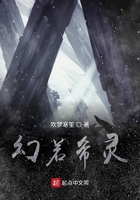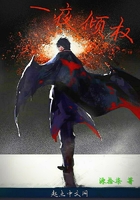The expected lightning radiates round,and a rumbling as from its subterranean vaults--if there are any--fills the castle.The lightning repeats itself,and,coming after the aforesaid thoughts of martial men,it bears a fanciful resemblance to swords moving in combat.It has the very brassy hue of the ancient weapons that here were used.The so sudden entry upon the scene of this metallic flame is as the entry of a presiding exhibitor who unrolls the maps,uncurtains the pictures,unlocks the cabinets,and effects a transformation by merely exposing the materials of his science,unintelligibly cloaked till then.The abrupt configuration of the bluffs and mounds is now for the first time clearly revealed--mounds whereon,doubtless,spears and shields have frequently lain while their owners loosened their sandals and yawned and stretched their arms in the sun.For the first time,too,a glimpse is obtainable of the true entrance used by its occupants of old,some way ahead.
There,where all passage has seemed to be inviolably barred by an almost vertical facade,the ramparts are found to overlap each other like loosely clasped fingers,between which a zigzag path may be followed--a cunning construction that puzzles the uninformed eye.
But its cunning,even where not obscured by dilapidation,is now wasted on the solitary forms of a few wild badgers,rabbits,and hares.Men must have often gone out by those gates in the morning to battle with the Roman legions under Vespasian;some to return no more,others to come back at evening,bringing with them the noise of their heroic deeds.But not a page,not a stone,has preserved their fame.
Acoustic perceptions multiply to-night.We can almost hear the stream of years that have borne those deeds away from us.Strange articulations seem to float on the air from that point,the gateway,where the animation in past times must frequently have concentrated itself at hours of coming and going,and general excitement.There arises an ineradicable fancy that they are human voices;if so,they must be the lingering air-borne vibrations of conversations uttered at least fifteen hundred years ago.The attention is attracted from mere nebulous imaginings about yonder spot by a real moving of something close at hand.
I recognize by the now moderate flashes of lightning,which are sheet-like and nearly continuous,that it is the gradual elevation of a small mound of earth.At first no larger than a man's fist it reaches the dimensions of a hat,then sinks a little and is still.
It is but the heaving of a mole who chooses such weather as this to work in from some instinct that there will be nobody abroad to molest him.As the fine earth lifts and lifts and falls loosely aside fragments of burnt clay roll out of it--clay that once formed part of cups or other vessels used by the inhabitants of the fortress.
The violence of the storm has been counterbalanced by its transitoriness.From being immersed in well-nigh solid media of cloud and hail shot with lightning,I find myself uncovered of the humid investiture and left bare to the mild gaze of the moon,which sparkles now on every wet grass-blade and frond of moss.
But I am not yet inside the fort,and the delayed ascent of the third and last escarpment is now made.It is steeper than either.The first was a surface to walk up,the second to stagger up,the third can only be ascended on the hands and toes.On the summit obtrudes the first evidence which has been met with in these precincts that the time is really the nineteenth century;it is in the form of a white notice-board on a post,and the wording can just be discerned by the rays of the setting moon:
CAUTION.--Any Person found removing Relics,Skeletons,Stones,Pottery,Tiles,or other Material from this Earthwork,or cutting up the Ground,will be Prosecuted as the Law directs.
Here one observes a difference underfoot from what has gone before:
scraps of Roman tile and stone chippings protrude through the grass in meagre quantity,but sufficient to suggest that masonry stood on the spot.Before the eye stretches under the moonlight the interior of the fort.So open and so large is it as to be practically an upland plateau,and yet its area lies wholly within the walls of what may be designated as one building.It is a long-violated retreat;all its corner-stones,plinths,and architraves were carried away to build neighbouring villages even before mediaeval or modern history began.Many a block which once may have helped to form a bastion here rests now in broken and diminished shape as part of the chimney-corner of some shepherd's cottage within the distant horizon,and the corner-stones of this heathen altar may form the base-course of some adjoining village church.
Yet the very bareness of these inner courts and wards,their condition of mere pasturage,protects what remains of them as no defences could do.Nothing is left visible that the hands can seize on or the weather overturn,and a permanence of general outline at least results,which no other condition could ensure.
The position of the castle on this isolated hill bespeaks deliberate and strategic choice exercised by some remote mind capable of prospective reasoning to a far extent.The natural configuration of the surrounding country and its bearing upon such a stronghold were obviously long considered and viewed mentally before its extensive design was carried into execution.Who was the man that said,'Let it be built here!'--not on that hill yonder,or on that ridge behind,but on this best spot of all?Whether he were some great one of the Belgae,or of the Durotriges,or the travelling engineer of Britain's united tribes,must for ever remain time's secret;his form cannot be realized,nor his countenance,nor the tongue that he spoke,when he set down his foot with a thud and said,'Let it be here!'















